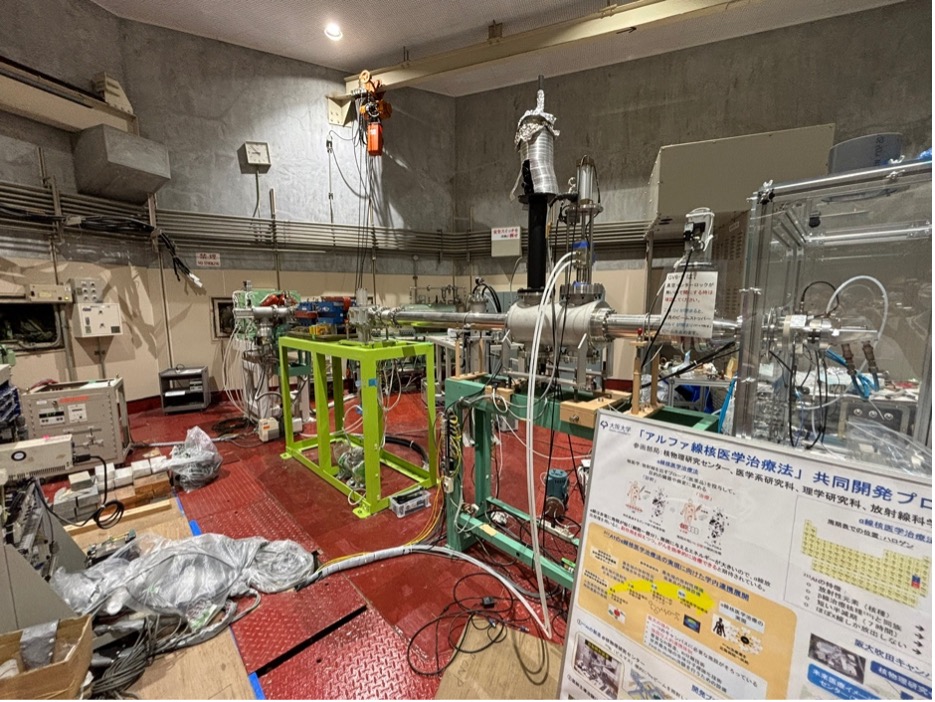
The accelerator located in RCNP. The pictures were taken by the author during a visit to RCNP at Osaka University


Targeted alpha therapy (TAT) is an emerging and highly promising form of radiopharmaceutical therapy that involves the use of alpha-emitting isotopes to target and destroy cancer cells in the human body by injecting alpha particle-emitting radionuclides into the tumor tissue. Astatine-211, an alpha particle-emitting radionuclide, has a high energy to kill tumor cells but low penetrating power, so the risk of damage to surrounding healthy tissue is reduced [1].
The Research Center for Nuclear Phsyics (RCNP) at Osaka University’s Suita Campus has the largest cyclotron accelerator on a university campus in Japan. Researchers utilise the RCNP cyclotron facility to perform various types of experiments, such as studying the structure and response of atomic nuclei, as well as investigating the mechanism of nucleosynthesis using light and heavy ions such as protons, alphas and oxygen ions. Astatine-211 is made by bombarding bismuth with helium followed by extraction using the accelerator. RCNP has the capability to mass-produce astatine-211 (211At), a radioisotope used in targeted alpha therapy (TAT) [2].

In Japan, Osaka University is set to begin the first clinical trial using astatine-211, marking the first in-human, investigator-initiated clinical trial for refractory thyroid cancer patients. This phase I trial will evaluate the safety, pharmacokinetics, and efficacy of astatine-211 for use in alpha therapy in patients with refractory differentiated thyroid cancer who have responded inadequately to the standard of care [3-4]. Compared to other alpha particle-emitting isotopes, astatine-211 offers several advantages, including a shorter half-life of 7.2 hours compared to Actinium-225's 10 days. Targeted Alpha Therapy (TAT), which can be used in patients with advanced refractory cancer in an outpatient setting, has immense potential to improve patients' quality of life and is expected to spur medical innovation in Japan and abroad.
Traditionally, radioactive iodine (¹³¹I) is used clinically for patients with differentiated thyroid cancer in isolated hospital rooms dedicated to radionuclide treatment. However, because radioactive iodine (¹³¹I) emits gamma rays, which have a long range, patients need to be admitted alone to special hospital rooms to protect others from radiation exposure. Compared to beta particles from ¹³¹I, alpha particles emitted from ²¹¹At have higher linear energy transfer, translating to better therapeutic effects by inducing DNA double strand breaks and free radical formation. Additionally, alpha rays emitted from ²¹¹At have a short range and do not travel outside the body, thus allowing for outpatient cancer treatment. ²¹¹At is poised to be a breakthrough treatment for metastatic thyroid cancer, especially in cases where conventional ¹³¹I therapy is ineffective. Additionally, ²¹¹At has the potential to be used as a therapeutic agent for other types of cancer.

The author visited RCNP and the Department of Nuclear Medicine at Osaka University Hospital as part of a collaboration between the Advanced Medical & Dental Institute, Universiti Sains Malaysia, and the Osaka University Graduate School of Medicine, Japan, through the Osaka University International Certification Program (OUICP). The author expresses sincere appreciation to the program manager, Associate Professor Dousatsu Sakata from the Division of Health Science, Graduate School of Medicine, for the opportunities provided.

1. Astatine-211: Japan’s strategic weapon against cancer https://www.nature.com/articles/d42473-023-00447-4
2. Mass production of Astatine at Cyclotron Facility at RCNP will promote advances in targeted alpha therapy https://www.osaka-u.ac.jp/en/news/topics/2024/02/29002
3. First in-human investigator-initiated clinical trial started for refractory thyroid cancer patients: Novel targeted alpha therapy using astatine. https://www.med.osaka-u.ac.jp/eng/archives/7164
4. Albertsson P, Bäck T, Bergmark K, Hallqvist A, Johansson M, Aneheim E, Lindegren S, Timperanza C, Smerud K, Palm S. Astatine-211 based radionuclide therapy: Current clinical trial landscape. Front Med (Lausanne). 2023 Jan 6;9:1076210. doi: 10.3389/fmed.2022.1076210. PMID: 36687417; PMCID: PMC9859440.